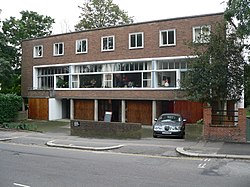2 Willow Road: Difference between revisions
m clean up, typos fixed: desireable → desirable |
No edit summary |
||
| (One intermediate revision by the same user not shown) | |||
| Line 22: | Line 22: | ||
1–3 Willow Road were constructed using concrete and a facing of red brick. A number of cottages were demolished to allow for the construction, and it was strongly opposed by a number of local residents including the future Conservative Home Secretary Henry Brooke and by the novelist Ian Fleming (this was said to be his inspiration for the name of the James Bond villain Auric Goldfinger). | 1–3 Willow Road were constructed using concrete and a facing of red brick. A number of cottages were demolished to allow for the construction, and it was strongly opposed by a number of local residents including the future Conservative Home Secretary Henry Brooke and by the novelist Ian Fleming (this was said to be his inspiration for the name of the James Bond villain Auric Goldfinger). | ||
No. 2, which Goldfinger designed specifically as his own family home, is the largest of the three houses and features a spiral staircase designed by Danish engineer Ove Arup at its core. The building is supported by a concrete frame, part of which is external, leaving room for a spacious uncluttered interior, perhaps inspired by the ''Raumplan'' ideas of modernist architect Adolf Loos.<ref>{{ | No. 2, which Goldfinger designed specifically as his own family home, is the largest of the three houses and features a spiral staircase designed by Danish engineer Ove Arup at its core. The building is supported by a concrete frame, part of which is external, leaving room for a spacious uncluttered interior, perhaps inspired by the ''Raumplan'' ideas of modernist architect Adolf Loos.<ref>{{NHLE|1379196|1, 2 and 3 Willow Road}}</ref> | ||
Goldfinger himself designed much of the furniture in No. 2, and the house also contains a significant collection of 20th-century art by Bridget Riley, Marcel Duchamp, Henry Moore and Max Ernst. | Goldfinger himself designed much of the furniture in No. 2, and the house also contains a significant collection of 20th-century art by Bridget Riley, Marcel Duchamp, Henry Moore and Max Ernst. | ||
| Line 29: | Line 29: | ||
==Outside links== | ==Outside links== | ||
{{Commons}} | |||
*{{NT link}} information at the National Trust | *{{NT link}} information at the National Trust | ||
Latest revision as of 12:03, 18 September 2019
| 2 Willow Road | |
|
National Trust | |
|---|---|
 1–3 Willow Road | |
| Grid reference: | TQ27128591 |
| Location: | 51°33’28"N, 0°10’4"W |
| Built 1939 | |
| Information | |
2 Willow Road in Hampstead, Middlesex, is part of a terrace of three fiercely modernist houses (1 to 3 Willow Road) designed by the architect Ernő Goldfinger. The houses were built in 1939.
Willow Road is a street in a desirable part of Hampstead, just south of Hampstead Heath and the houses overlook a little open space, Preacher's Hill, at the foot of the heath.
The middle house, 2 Willow Road, has been managed by the National Trust since 1995 and is open to the public. It was one of the first modernist buildings acquired by the Trust, giving rise to some controversy. Goldfinger himself lived there with his wife Ursula and their children until his death in 1987.
1–3 Willow Road were constructed using concrete and a facing of red brick. A number of cottages were demolished to allow for the construction, and it was strongly opposed by a number of local residents including the future Conservative Home Secretary Henry Brooke and by the novelist Ian Fleming (this was said to be his inspiration for the name of the James Bond villain Auric Goldfinger).
No. 2, which Goldfinger designed specifically as his own family home, is the largest of the three houses and features a spiral staircase designed by Danish engineer Ove Arup at its core. The building is supported by a concrete frame, part of which is external, leaving room for a spacious uncluttered interior, perhaps inspired by the Raumplan ideas of modernist architect Adolf Loos.[1]
Goldfinger himself designed much of the furniture in No. 2, and the house also contains a significant collection of 20th-century art by Bridget Riley, Marcel Duchamp, Henry Moore and Max Ernst.
Entry is by timed ticket, and facilities are very limited. Nos. 1 and 3 remain private homes.
Outside links
| ("Wikimedia Commons" has material about 2 Willow Road) |
- 2 Willow Road information at the National Trust
References
- ↑ National Heritage List 1379196: 1, 2 and 3 Willow Road
- Warburton, Nigel. Ernő Goldfinger: The Life of an Architect (Routledge, 2004) ISBN 0-415-25853-7.
- Camden listed buildings information
